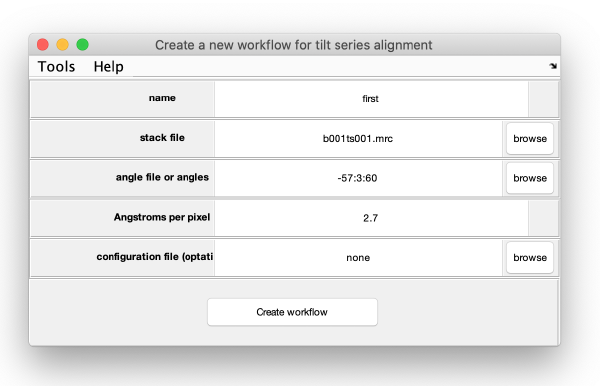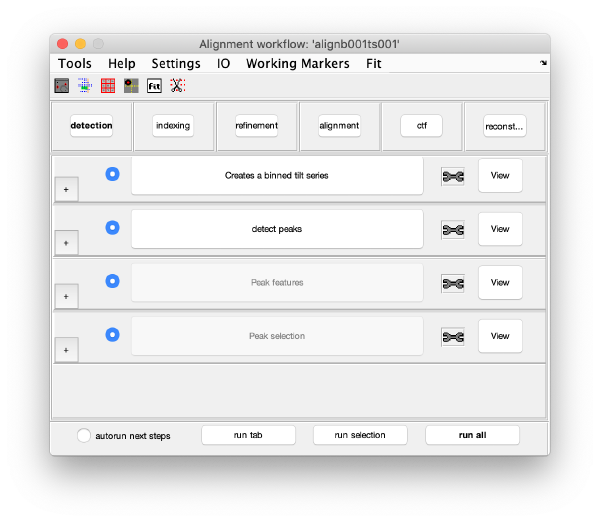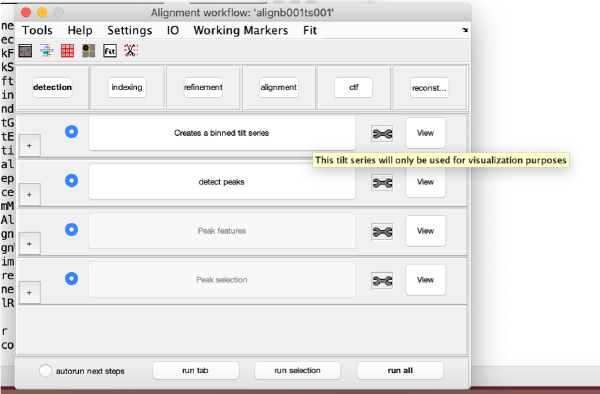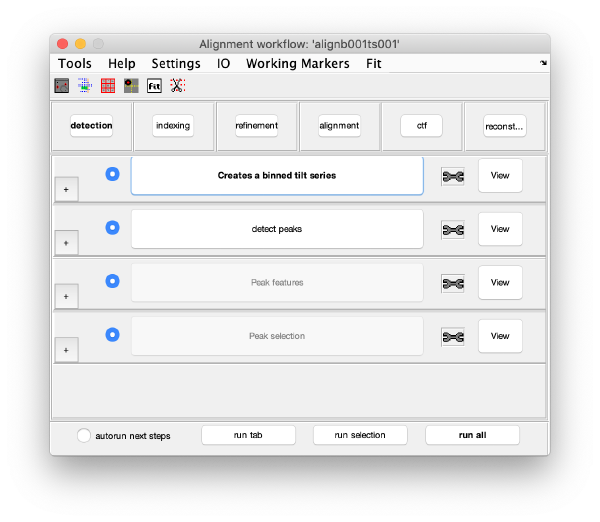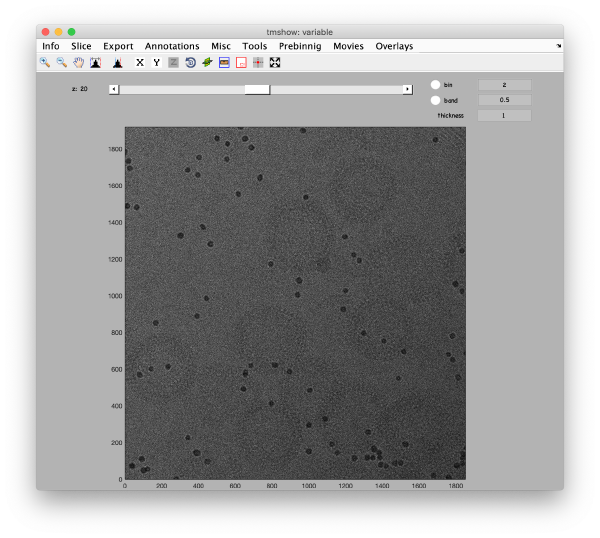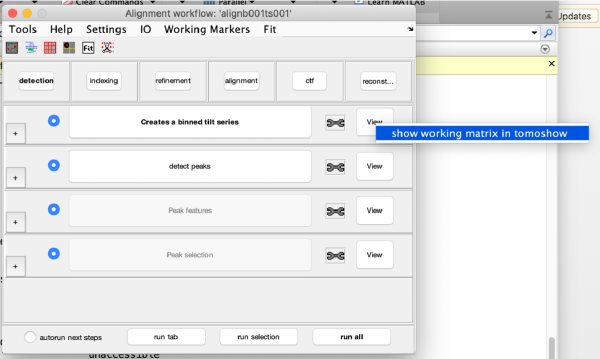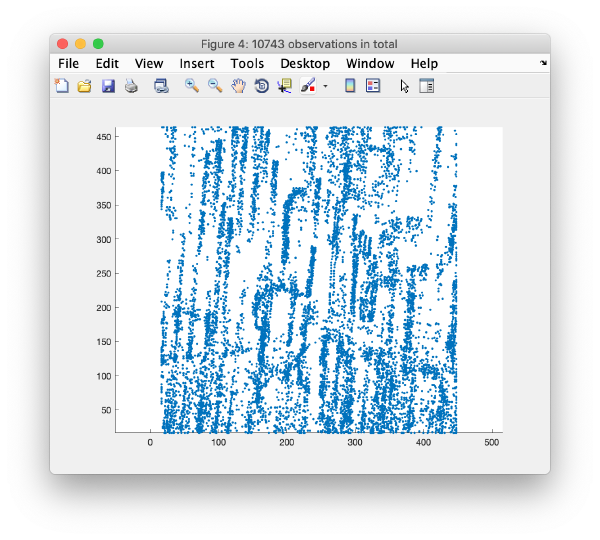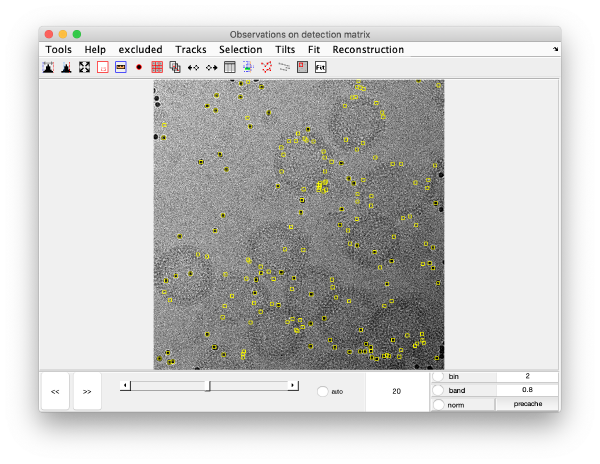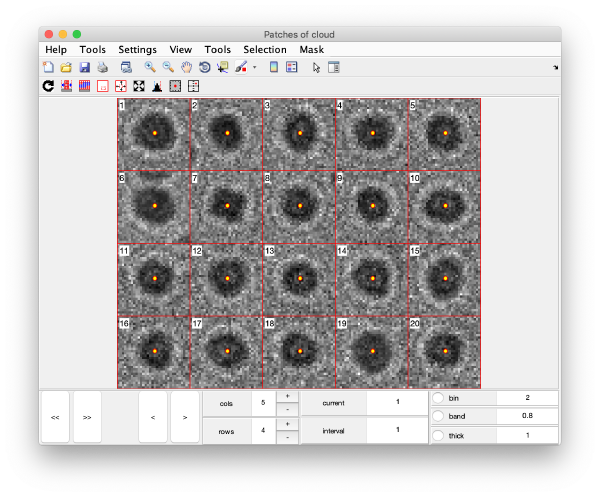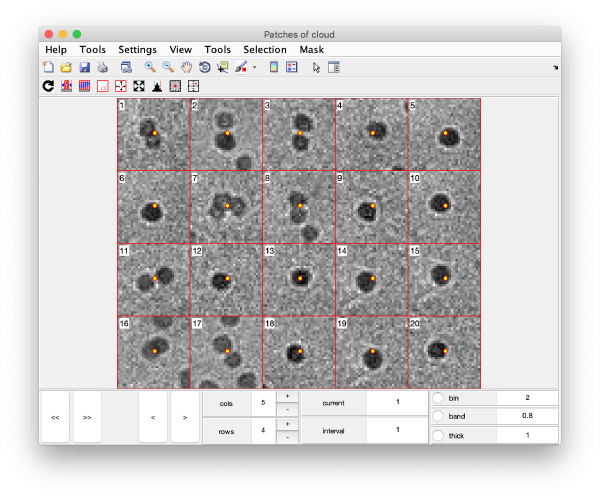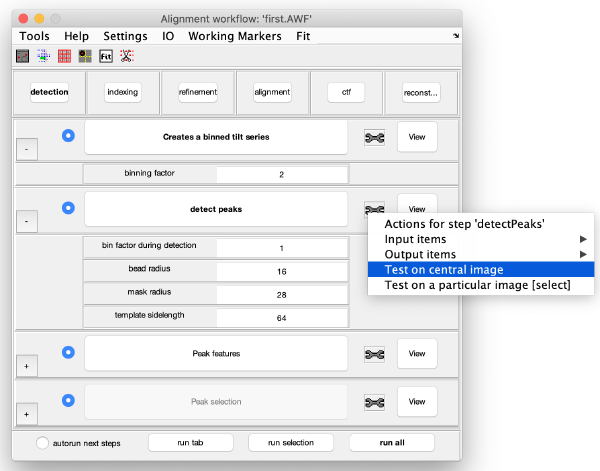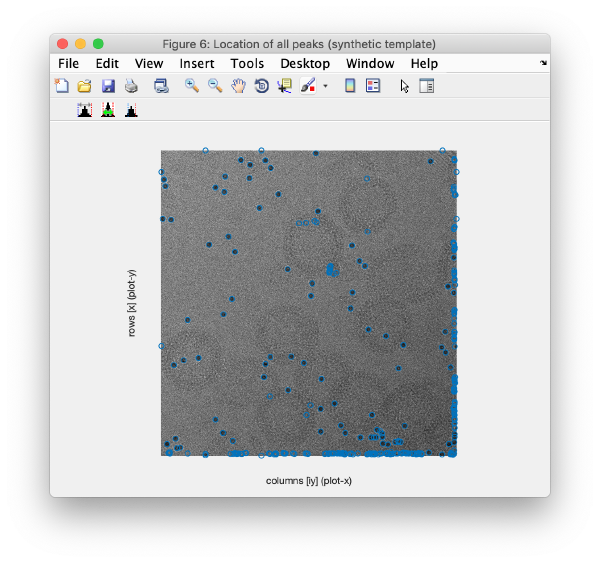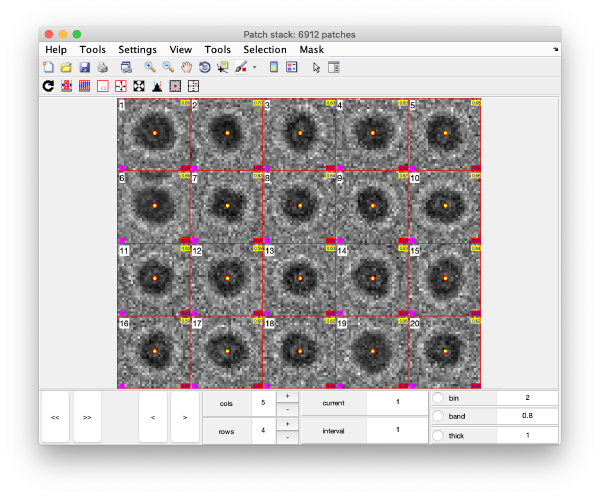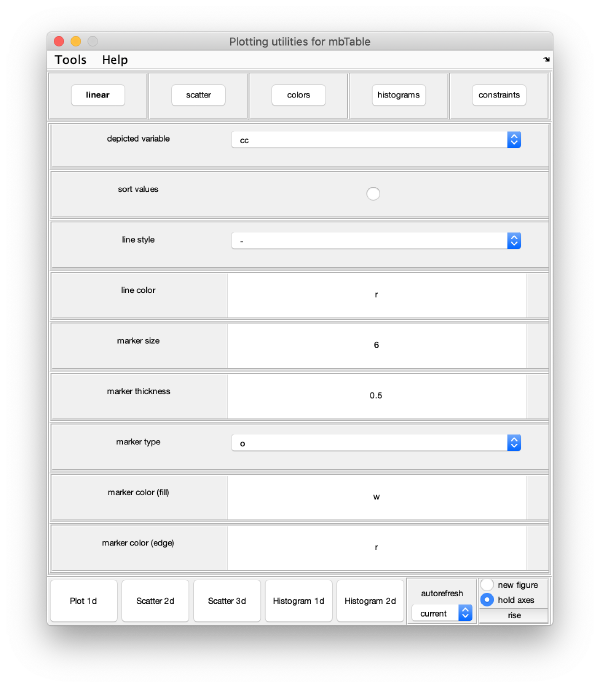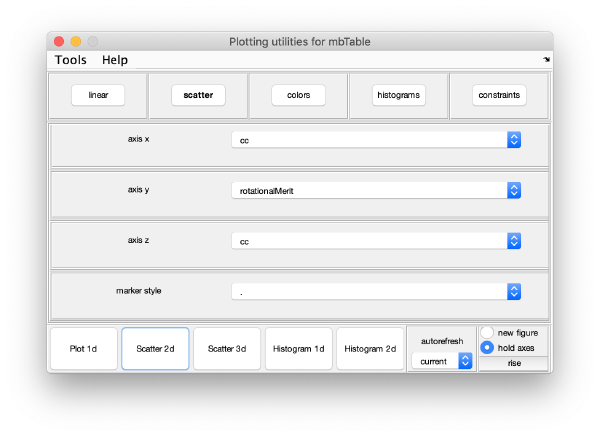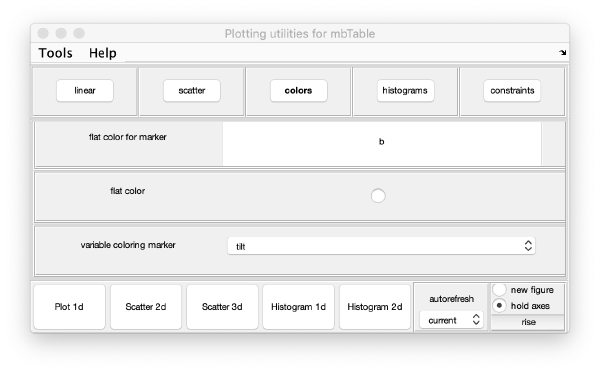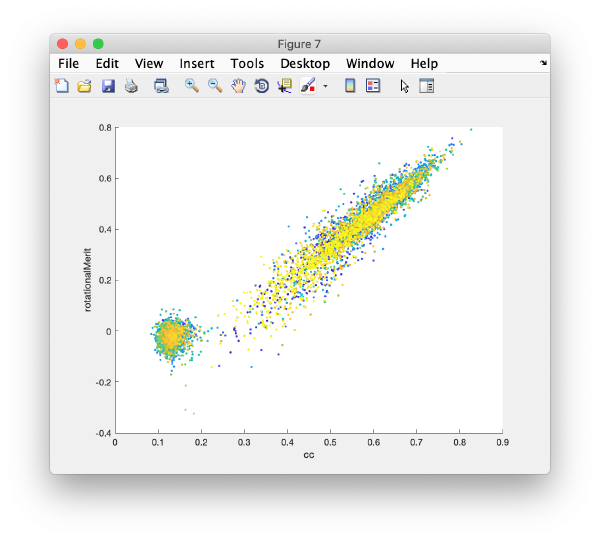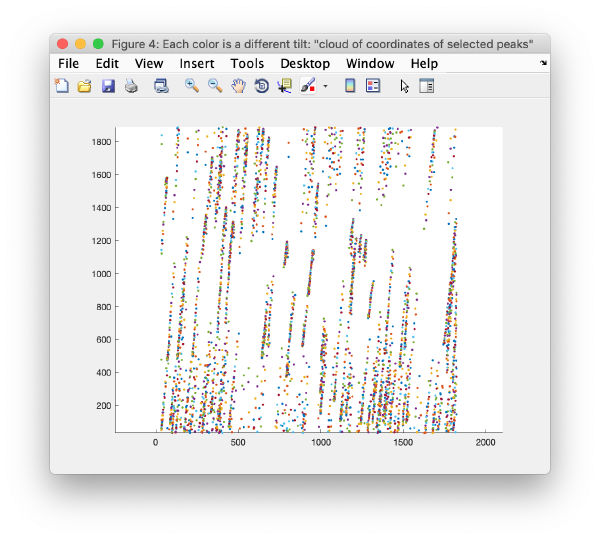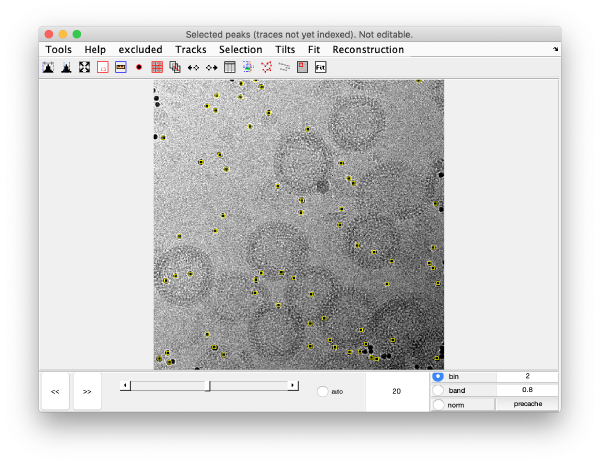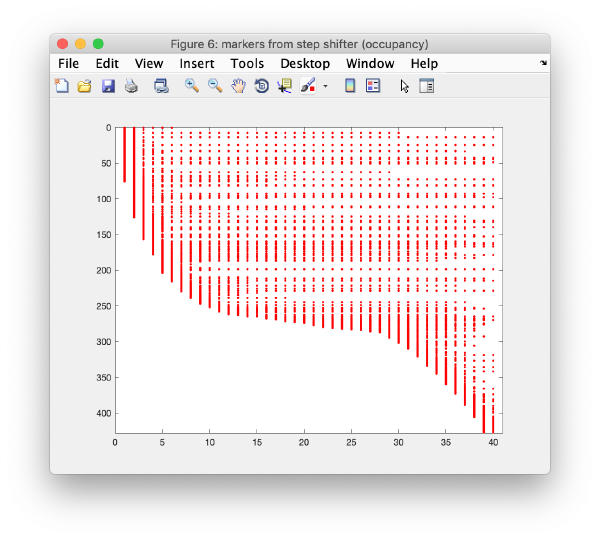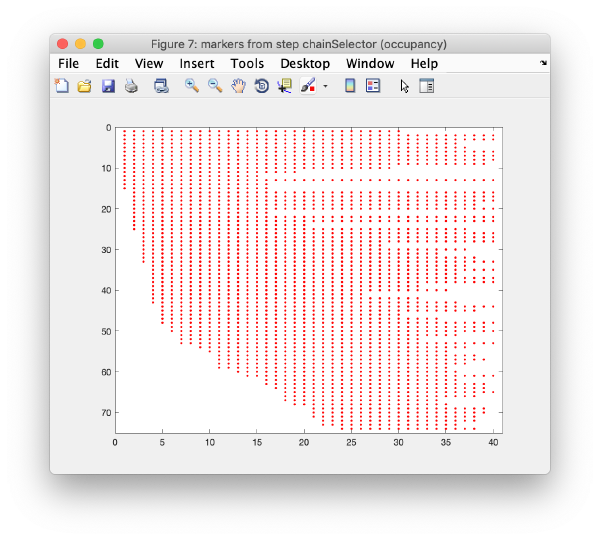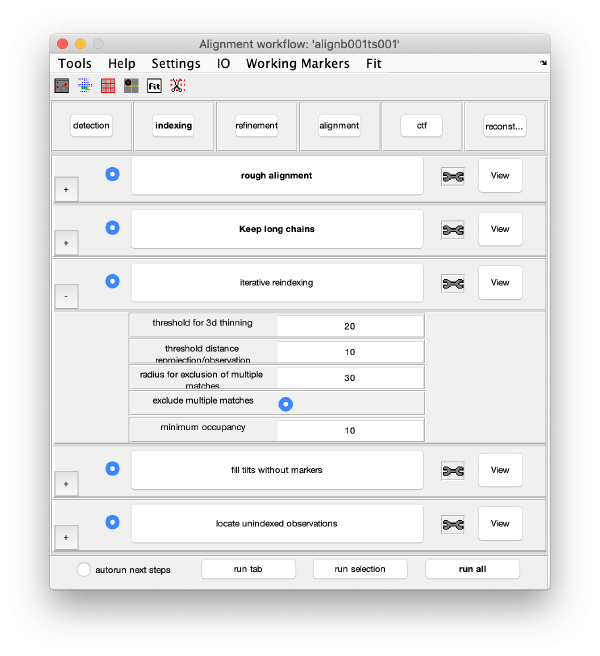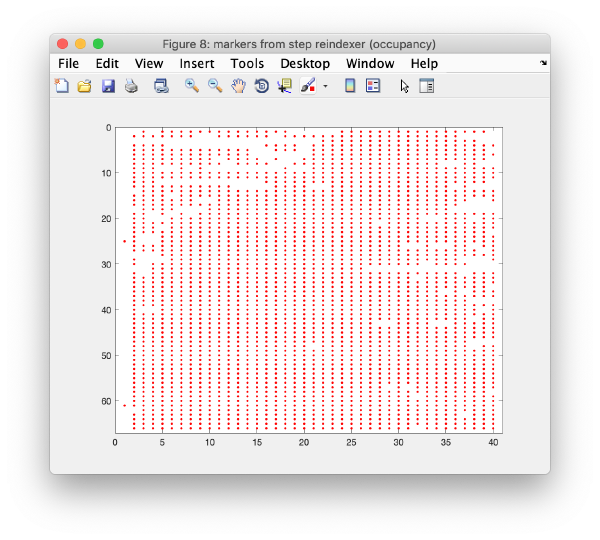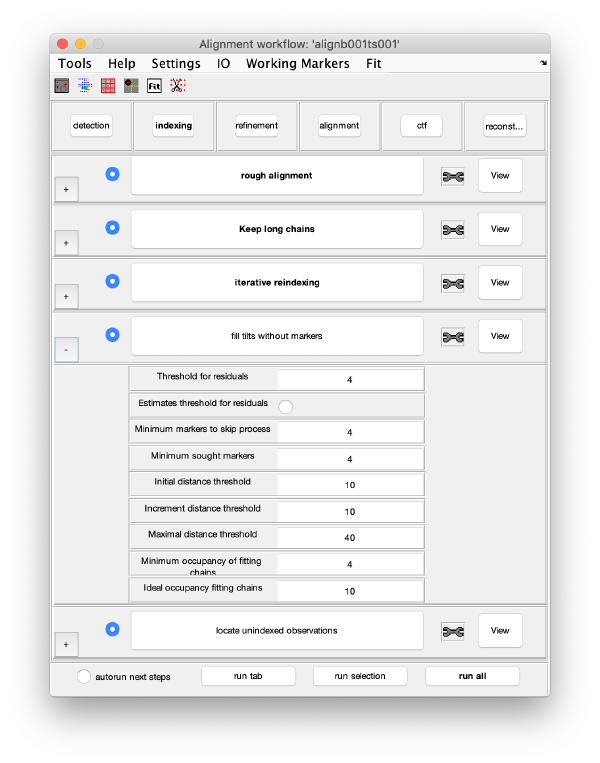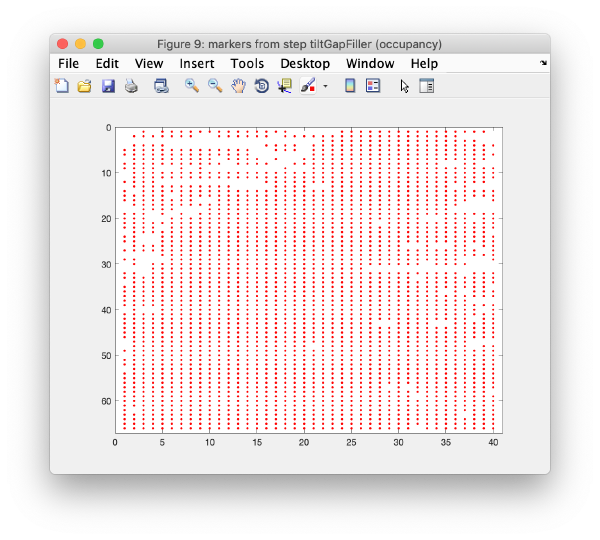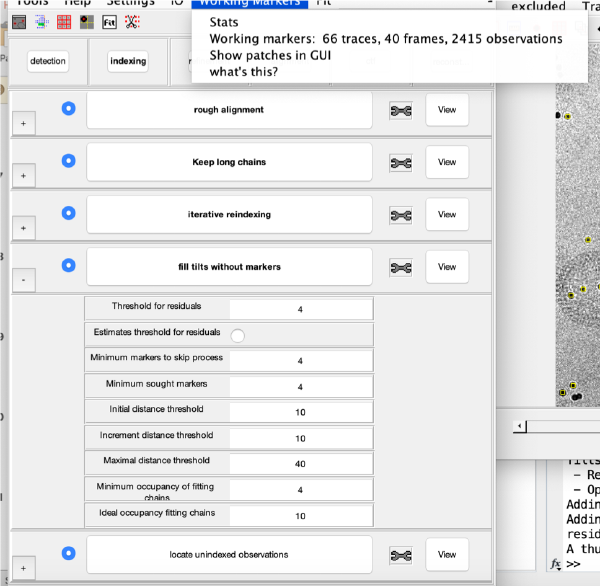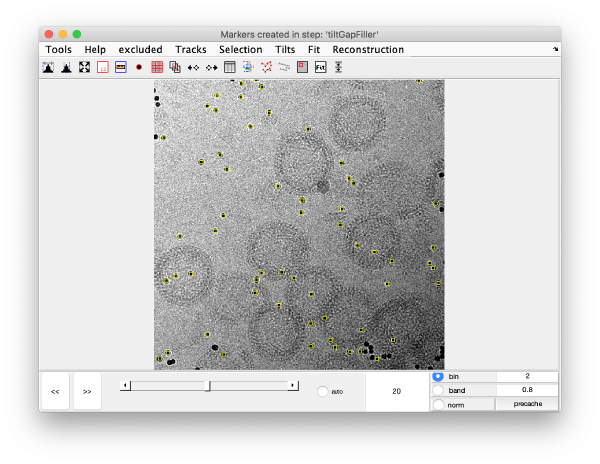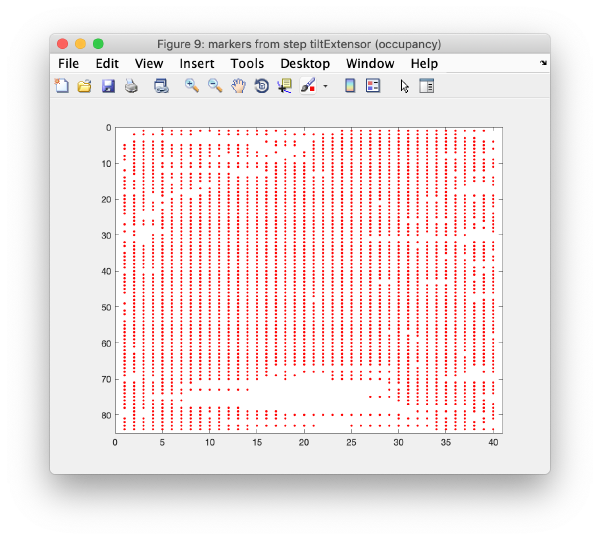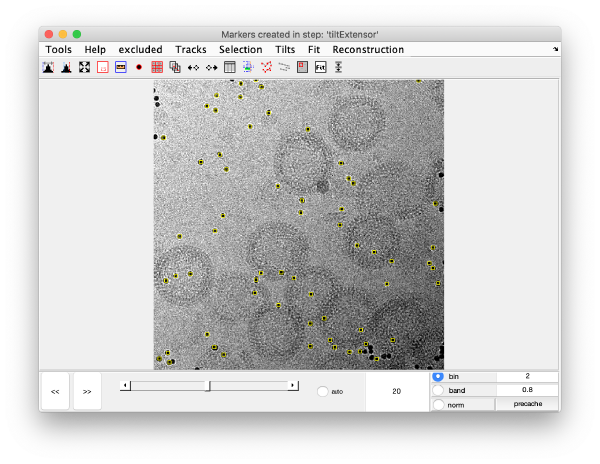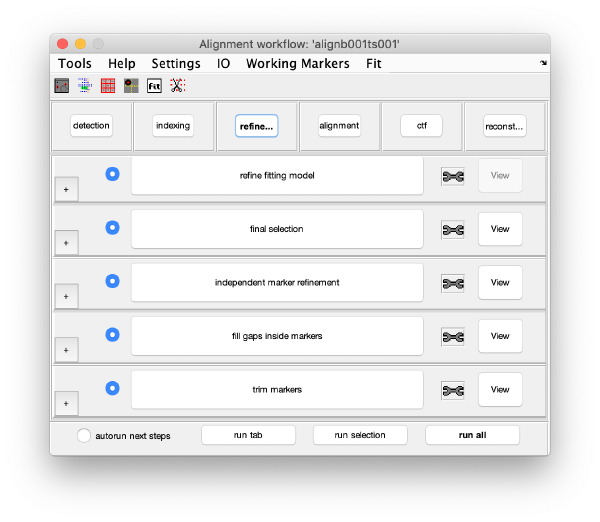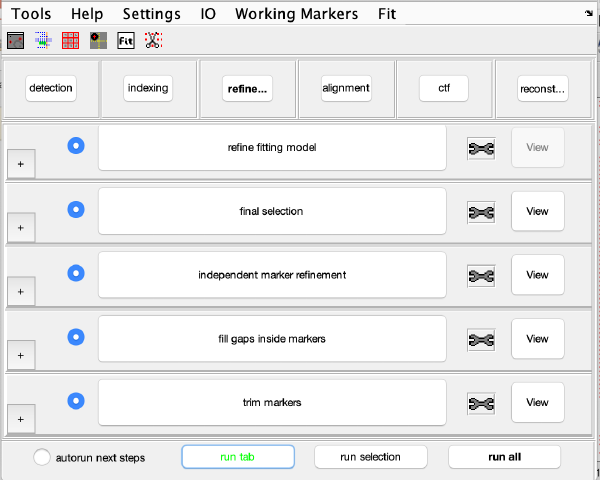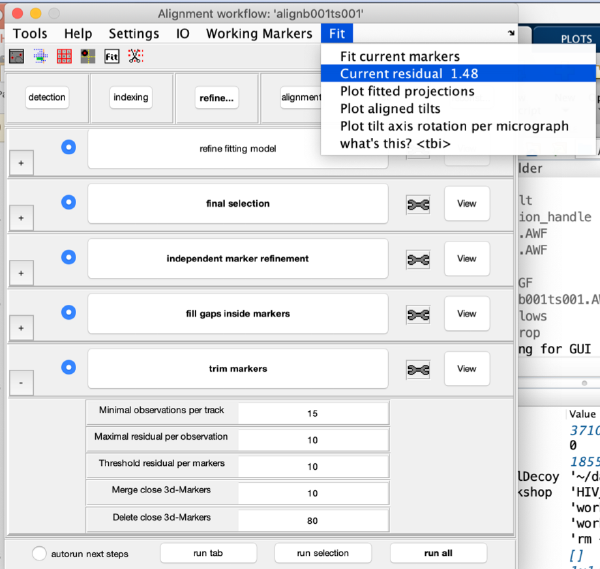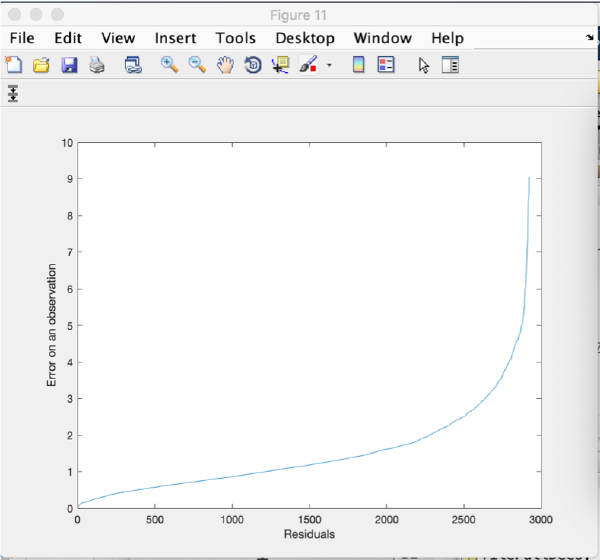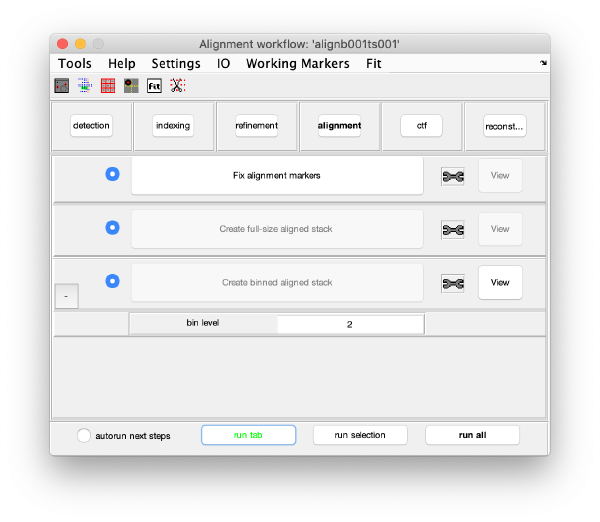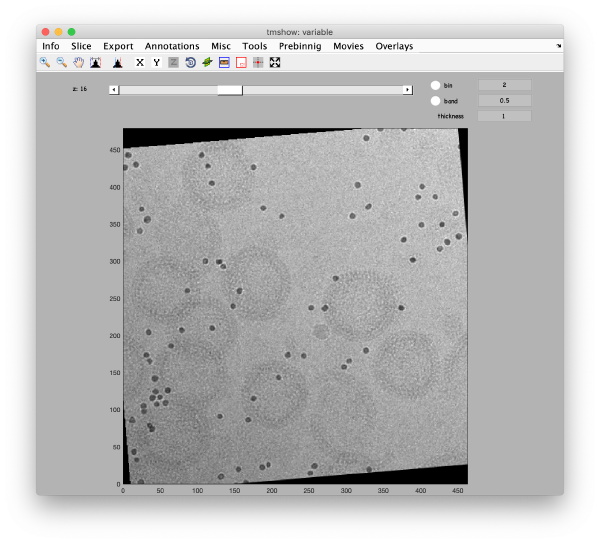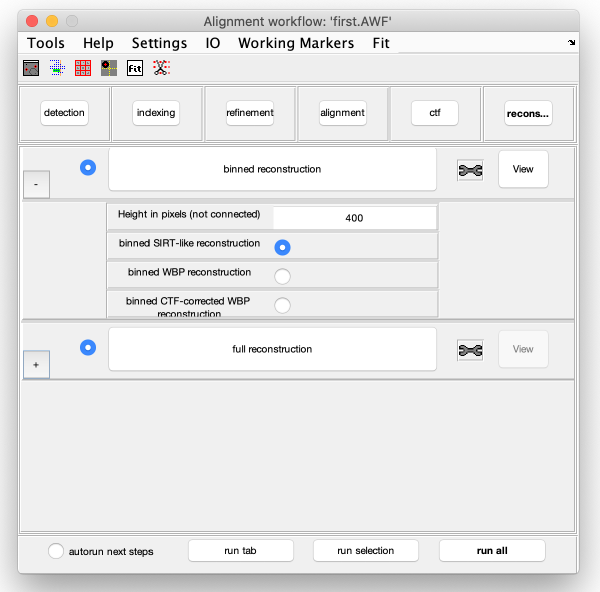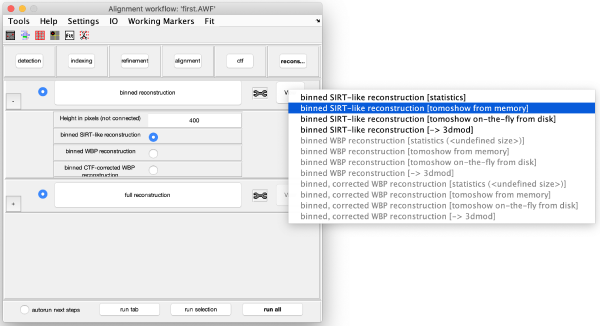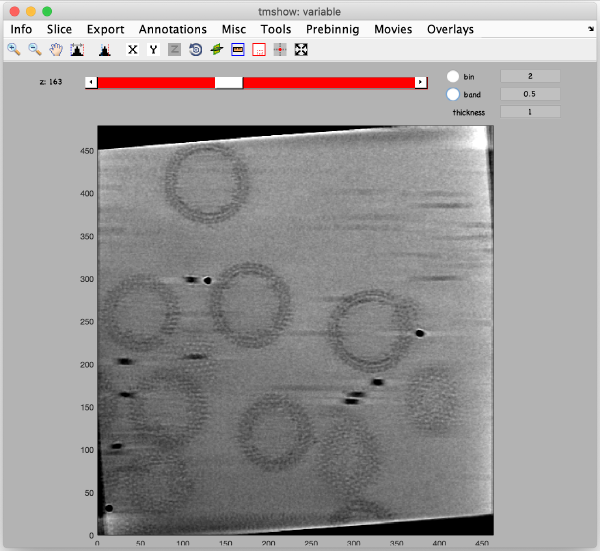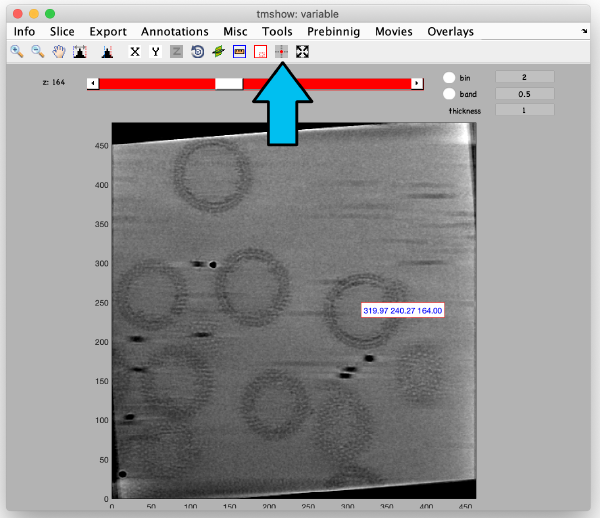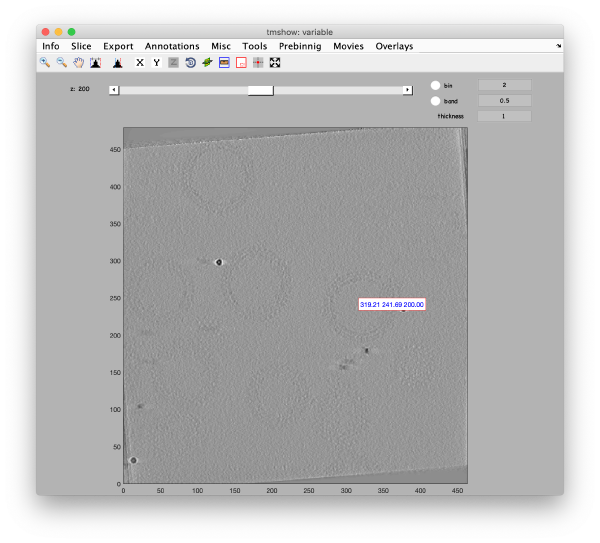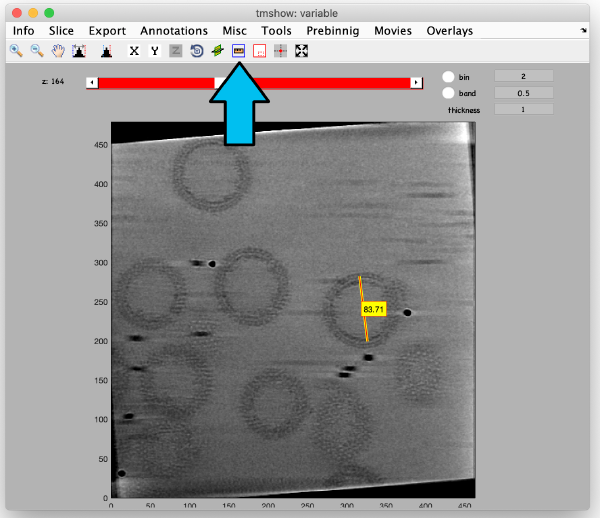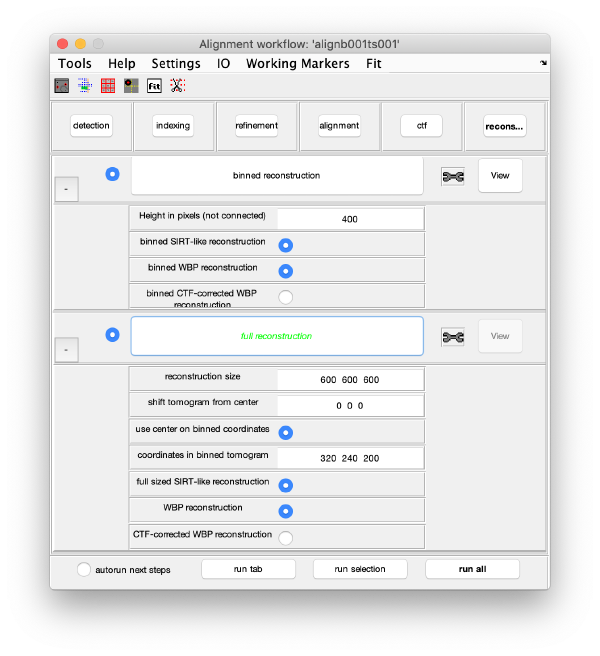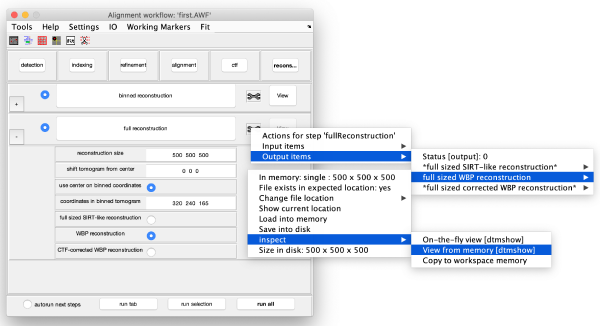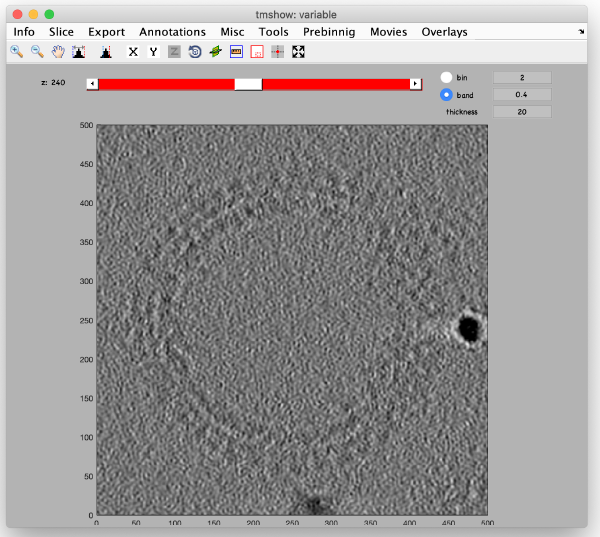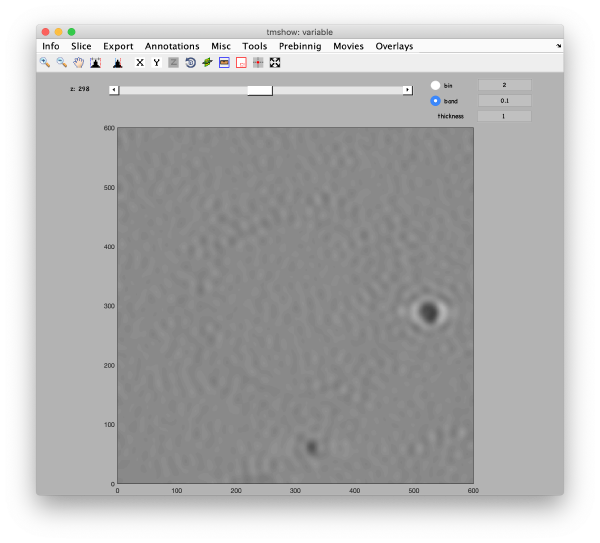Difference between revisions of "Walkthrough on GUI based tilt series alignment"
| Line 133: | Line 133: | ||
== Indexing == | == Indexing == | ||
| − | The goal of this task is to find ''trails'' of gold beads, i.e., observations in different micrographs that correspond to the same 3d gold bead. | + | The goal of this task is to find ''trails'' of gold beads, i.e., observations in different micrographs that correspond to the same 3d gold bead. All the steps in this area will update a set of "working markers". |
=== Rough Alignment === | === Rough Alignment === | ||
| Line 153: | Line 153: | ||
===Tilt gap filling === | ===Tilt gap filling === | ||
| − | ''Dynamo'' can be directed to try | + | ''Dynamo'' can be directed to try to analyse those tilts that wind up not having any marker (and that have not been explicitly rejected by the user). The cloud of observations found on that micrograph will be compared to the cloud or reproductions generated by the current model. |
[[ File:alignGUI_parametersForTiltGapFiller.png |thumb|center| 600px|parameters for tilt gap filler]] | [[ File:alignGUI_parametersForTiltGapFiller.png |thumb|center| 600px|parameters for tilt gap filler]] | ||
[[ File:alignGUI_occupancyAfterTiltGapFiller.png |thumb|center| 600px|occupancy after tilt gap filler]] | [[ File:alignGUI_occupancyAfterTiltGapFiller.png |thumb|center| 600px|occupancy after tilt gap filler]] | ||
Revision as of 17:47, 27 August 2019
Dynamo includes a package for automated aligned and reconstruction of tilt series. This walkthrough guides you through the steps on how to use it with a GUI. A different page in this wiki shows how to operate this procedure through the command line.
Contents
Data
We have prepared a version of a tilt series from the EMPIAR entry [XXXX], containing a set of virus like particles of VLP.
< tt> wget https://wiki.dynamo.biozentrum.unibas.ch/html/w/doc/data/hiv/align/b001ts001.mrc
In a Mac:
curl -O https://wiki.dynamo.biozentrum.unibas.ch/html/w/doc/data/hiv/align/b001ts001.mrc
In the workshop, a copy should be already available on your local data folder:
~/data/b001ts001.mrc
In this binned version, the pixel size is 2'7 Angstrom (original was 1.35, this is bin level 1 in Dynamo)
Creating an alignment workflow
The basic function for invoking the GUI is dtsa (short form of dynamo_tilt_series_alignment;
u = dtsa();
Here, u is an object that will reside in memory during the session and allows to interoperate with the workflow through the command line. It is not necessary when proceeding through the GUI.
The data for the workflow (tilt series, angles) could have been introduced directly when creating the workflow, we however will introduce each item explicitly in this walkthrough.
The minimal data to initiate a workflow is
- tilt series matrix (use the file indicated above)
- tilt angles.
- discarded tilt angles (leave empty)
Discarded tilt angles
If you are unsure on the tilts to be discarded, you can do it in a later stage while you inspect the images in the dmarkers GUI, using the x and shift + x buttons.
GUI description
The GUI guides of the process of creating and editing a set of "working markers" (in the areas of detection, reindexing and refinement), and then using them to create aligned stacks (alignment tab), analyse and correct their CTF (through wrappers to ctfffind4 and imod) and then create reconstructions.
Settings
Acquisition settings
Here you can enter pixel size (2.7 Angstroms), Cs (2.2), nominal defocus (-4.0 microns, used if the CTF area is connected).
Controls
markers GUI
The icon of the markers GUI allows you to check the position of the working markers in the micrograph. If you want to make editions of the GUI permanent, you need to save the current markers.
Occupancy plot
Shows a scheme of which markers are present in which tilt numbers.
Gold bead gallery
Crops the gold beads currently contained in the working markers and shows them as a gallery.
Execution Areas
The GUI is divided in five areas. Each are comprises sets of steps that can be executed sequentially. Sequential execution is the natural way of proceeding; but steps can be visited in any order, i.e., a step can be reexecuted in a later moment after updating its information.
Steps
Steps needs to be open (letters in black, not grey) in order to be executed. They become open when the input they require gets computed and stored by a previous step during execution of the workflow. When a step is under execution, its pushbutton becomes green.
Step Toolbox
The tool icon can be secondary clicked and will provide a popup menu with specific tools for each steps and some common one. The common ones are handles to inspect and list the items that are needed (input items) or generated (output items) by the step. The View provides tools specific for visualisation of results of the step.
The areas in the alignment task
Detection
The goal of this task is to find the positions of the gold bead projections in the tilt series. We will cross correlate each micrograph against a model of the gold bead and then locate the cross correlation peaks, which provide putative positions for actual projections of gold beads. Further analysis (feature extraction and "selection") of these peaks will determine which ones correspond to actual gold bead projection.
Visualization matrix
This step just creates a binned version of the tilt series stack to accelerate visualizations that will be invoked in a later point.
Detection of gold beads
This area is the one that needed some design decision on the size of the gold bead. We will use dtmshow
Right click on the view area of the step to access the different visualisation options.
This view shows the x,y coordinates of all cross correlation peaks on all the micrographs in the tilt series.
We can also check the positions of all the detected spots on each micrograph:
This GUI does not allow for edition of the markers.
The neighbourhood of cross correlation peaks can be visualised individually:
This visualization is normally a good gauge on how the detection procedure has worked. The example below would be an example of detection procedure carried with wrong search parameters
Note that you have the option of testing your parameters against a single image before launching a full detection procedure.
Computation of observation features s
At this stage, the observed cross correlation peaks are analysed. In the current Dynamo' version a merit figure is assigned to each peak based on a "rotational merit" that measures its similarity to a circle. The results can be depicted on patches representing individual gold beads:
or extracting properties of the whole data set.
Selection of best gold beads
The cluster with the best markers is then selected. The individual patches can be inspected
or, again the cloud of observations
and the location of the observations in the micrographs:
Indexing
The goal of this task is to find trails of gold beads, i.e., observations in different micrographs that correspond to the same 3d gold bead. All the steps in this area will update a set of "working markers".
Rough Alignment
Here all couples of micrographs are compared. For each couple, we look for the relative shifts that generates the most matches of cross-correlation peaks between one micrograph and the next one. This procedure induces trails of matched pairs of observations of variable length along the tilt series. The scheme that depicts which trails have representatives in which tilts is called occupancy graph
Note that these trails are very lacunary and don't conserve the identity of a trail; whenever a trail that represents an actual 3d marker gets interrupted, the same 3d marker might generate a different trail in other tilts.
Selection of stable trails
We select the longest trails, which will then be used to generate a 3d model of the markers:
Note that from this step onwards, the toolbox of each step offers the possibility to revert the current markers to the output generated at that state. Thus, if further processing of the markers in a later step leads you to loose a good marker set, you can always come back to this point.
Iterative reindexing
The 3d model is projected on each micrograph. Observations that are closest (and below a distance threshold) to each reprojection are assigned to the corresponding 3d marker. This refines the 3d model, and the process is iterated till no further improvement occurs (or till a maximum of ten iterations is reached).
Tilt gap filling
Dynamo can be directed to try to analyse those tilts that wind up not having any marker (and that have not been explicitly rejected by the user). The cloud of observations found on that micrograph will be compared to the cloud or reproductions generated by the current model.
Trail extension
Refinement
Alignment
This area creates the aligned tilt series. It creates two version, a binned one and one with full resolution pixel size. Note that the binning level of this one is independent of the binning level used in the detection step.
Fix the markers
Here we just freeze the working markers and create a marker file that will define all subsequent steps of alignment and reconstruction.
Align the tilt series
We then proceed to the alignment task itself.
CTF
In this GUI CTF estimation and correction are delegated to CTFFIND4 and Imod's ctfphaseflip programs respectively. This part will not be used in the workshop.'
Reconstruction
Binned reconstruction
This version of Dynamo fixes the tomogram center at the 3d reconstruction center of the aligned stack.
Full sized reconstruction
The full sized reconstruction can be created related to a coordinate directly read in the binned tomogram, a feature useful for creating reconstructions localised on an area of interest. In this case, we will focus on one of the VLPS.
Use the pin tool to select a point on the binned reconstruction.
We also check the size of a structure of interest. We measure it in the binned tomogram.
]

